Chronic Supplementation of Paeonol Combined with Danshensu for the Improvement of Vascular Reactivity in the Cerebral Basilar Artery of Diabetic Rats
Abstract
:1. Introduction
2. Results
2.1. Effect of Pae + DSS on Body Weight and Blood Glucose
2.2. Activation of Pae + DSS Induced Relaxation in Rat Cerebral Artery
2.3. Effect of Chronic Pae + DSS Administration on ACh Relaxation Response and Phenylephrine (PE) Contraction Response
2.4. Influence of Pae + DSS on Calcium and Potassium Channel
2.5. Effects of Pae + DSS on SOD Activities and TBARS Content in the Cerebral Artery from Diabetic Rats
3. Discussion
4. Materials and Methods
4.1. Animals
4.2. Vascular Reactivity
4.3. Effect of Pae + DSS on the Basal Tonus of Arterial Rings
4.4. Effect of Chronic Pae + DSS Administration on the Relaxation Response to ACh and the Contraction Response to PE
4.5. Effect of Chronic Pae + DSS Administration on the Contraction Response to PE and CaCl2 in Ca2+-Free Solution
4.6. Effect of K+ Channel Blockers on Pae + DSS Induced Vascular Reactivity
4.7. SOD Activity Assay and TBARS Level
4.8. Statistical Analysis
5. Conclusions
Acknowledgments
References
- Wu, J.B.; Song, N.N.; Wei, X.B.; Guan, H.S.; Zhang, X.M. Protective effects of paeonol on cultured rat hippocampal neurons against oxygen-glucose deprivation-induced injury. J. Neurol. Sci 2008, 264, 50–55. [Google Scholar]
- Li, H.; Wang, S.W.; Zhang, B.L.; Xie, Y.H.; Yang, Q.; Cao, W.; Wang, J.B. Simultaneous quantitative determination of 9 active components in traditional Chinese medicinal preparation ShuangDan oral liquid by RP-HPLC coupled with photodiode array detection. J. Pharm. Biomed. Anal 2011, 56, 820–824. [Google Scholar]
- Lau, C.H.; Chan, C.M.; Chan, Y.W.; Lau, K.M.; Lau, T.W.; Lam, F.C.; Law, W.T.; Che, C.T.; Leung, P.C.; Fung, K.P.; et al. Pharmacological investigations of the anti-diabetic effect of Cortex Moutan and its active component paeonol. Phytomedicine 2007, 14, 778–784. [Google Scholar]
- Mi, X.J.; Chen, S.W.; Wang, W.J.; Wang, R.; Zhang, Y.J.; Li, W.J.; Li, Y.L. Anxiolytic-like effect of paeonol in mice. Pharmacol. Biochem. Behav 2005, 81, 683–687. [Google Scholar]
- Hu, P.; Luo, G.A.; Zhao, Z.; Jiang, Z.H. Quality assessment of Radix Salviae miltiorrhizae. Chem. Pharm. Bull. (Tokyo) 2005, 53, 481–486. [Google Scholar]
- Lam, F.F.; Yeung, J.H.; Chan, K.M.; Or, P.M. Relaxant effects of danshen aqueous extract and its constituent danshensu on rat coronary artery are mediated by inhibition of calcium channels. Vasc. Pharmacol 2007, 46, 271–277. [Google Scholar]
- Chan, K.; Chui, S.H.; Wong, D.Y.; Ha, W.Y.; Chan, C.L.; Wong, R.N. Protective effects of Danshensu from the aqueous extract of Salvia miltiorrhiza (Danshen) against homocysteine-induced endothelial dysfunction. Life Sci 2004, 75, 3157–3171. [Google Scholar]
- Li Volti, G.; Salomone, S.; Sorrenti, V.; Mangiameli, A.; Urso, V.; Siarkos, I.; Galvano, F.; Salamone, F. Effect of silibinin on endothelial dysfunction and ADMA levels in obese diabetic mice. Cardiovasc. Diabetol 2011, 10, 62. [Google Scholar]
- Zhang, N.; Zou, H.; Jin, L.; Wang, J.; Zhong, M.F.; Huang, P.; Gu, B.Q.; Mao, S.L.; Zhang, C.; Chen, H. Biphasic effects of sodium danshensu on vessel function in isolated rat aorta. Acta Pharmacol. Sin 2010, 31, 421–428. [Google Scholar]
- Li, Y.J.; Bao, J.X.; Xu, J.W.; Murad, F.; Bian, K. Vascular dilation by paeonol—A mechanism study. Vasc. Pharmacol 2010, 53, 169–176. [Google Scholar]
- Yang, G.D.; Zhang, H.; Lin, R.; Wang, W.R.; Shi, X.L.; Liu, Y.; Ji, Q.L. Down-regulation of CD40 gene expression and inhibition of apoptosis with Danshensu in endothelial cells. Basic Clin. Pharmacol. Toxicol 2009, 104, 87–92. [Google Scholar]
- Min, C.Y.; Liu, H.Q.; Zhan, F.; Qiu, W.Z. Effect of paeonol on protecting endothelial cells of diabetic rats. Zhong Yao Cai 2009, 32, 564–567. [Google Scholar]
- Yang, Q.; Wang, S.W.; Xie, Y.H. Protective effect of Shuangdan capsule on cerebral ischemia injury-reperfusion in rats. Prog. Mod. Biomed 2009, 9, 3861–3863. [Google Scholar]
- Yang, Q.; Wang, S.; Xie, Y.; Wang, J.; Li, H.; Zhou, X.; Liu, W. Effect of salvianolic acid B and paeonol on blood lipid metabolism and hemorrheology in myocardial ischemia rabbits induced by pituitruin. Int. J. Mol. Sci 2010, 11, 3696–3704. [Google Scholar]
- Li, H.; Wang, S.; Zhang, B.; Xie, Y.; Wang, J.; Yang, Q.; Cao, W.; Hu, J.; Duan, L. Influence of co-administered danshensu on pharmacokinetic fate and tissue distribution of paeonol in rats. Planta Med 2011, 78, 135–140. [Google Scholar]
- Wang, Y.; Liu, L.; Hu, C.; Cheng, Y. Effects of Salviae Mitiorrhizae and Cortex Moutan extract on the rat heart after myocardial infarction: A proteomic study. Biochem. Pharmacol 2007, 74, 415–424. [Google Scholar]
- Takenouchi, Y.; Kobayashi, T.; Taguchi, K.; Matsumoto, T.; Kamata, K. Gender differences in endothelial function in aortas from type 2 diabetic model mice. J. Pharmacol. Sci 2009, 111, 91–99. [Google Scholar]
- Natali, A.; Toschi, E.; Baldeweg, S.; Casolaro, A.; Baldi, S.; Sironi, A.M.; Yudkin, J.S.; Ferrannini, E. Haematocrit, type 2 diabetes, and endothelium-dependent vasodilatation of resistance vessels. Eur. Heart J 2005, 26, 464–471. [Google Scholar]
- Peiro, C.; Lafuente, N.; Matesanz, N.; Cercas, E.; Llergo, J.L.; Vallejo, S.; Rodriguez-Manas, L.; Sanchez-Ferrer, C.F. High glucose induces cell death of cultured human aortic smooth muscle cells through the formation of hydrogen peroxide. Br. J. Pharmacol 2001, 133, 967–974. [Google Scholar]
- Okon, E.B.; Szado, T.; Laher, I.; McManus, B.; van Breemen, C. Augmented contractile response of vascular smooth muscle in a diabetic mouse model. J. Vasc. Res 2003, 40, 520–530. [Google Scholar]
- Pandolfi, A.; Grilli, A.; Cilli, C.; Patruno, A.; Giaccari, A.; Di Silvestre, S.; De Lutiis, M.A.; Pellegrini, G.; Capani, F.; Consoli, A.; et al. Phenotype modulation in cultures of vascular smooth muscle cells from diabetic rats: Association with increased nitric oxide synthase expression and superoxide anion generation. J. Cell Physiol 2003, 196, 378–385. [Google Scholar]
- Redondo, S.; Ruiz, E.; Santos-Gallego, C.G.; Padilla, E.; Tejerina, T. Pioglitazone induces vascular smooth muscle cell apoptosis through a peroxisome proliferator-activated receptor-gamma, transforming growth factor-beta1, and a Smad2-dependent mechanism. Diabetes 2005, 54, 811–817. [Google Scholar]
- Shi, Y.; Feletou, M.; Ku, D.D.; Man, R.Y.; Vanhoutte, P.M. The calcium ionophore A23187 induces endothelium-dependent contractions in femoral arteries from rats with streptozotocin-induced diabetes. Br. J. Pharmacol 2007, 150, 624–632. [Google Scholar]
- Karasu, C. Increased activity of H2O2 in aorta isolated from chronically streptozotocin-diabetic rats: Effects of antioxidant enzymes and enzymes inhibitors. Free Radic. Biol. Med 1999, 27, 16–27. [Google Scholar]
- Spitaler, M.M.; Graier, W.F. Vascular targets of redox signalling in diabetes mellitus. Diabetologia 2002, 45, 476–494. [Google Scholar]
- Okudan, N.; Bariskaner, H.; Gokbel, H.; Sahin, A.S.; Belviranli, M.; Baysal, H. The effect of supplementation of grape seed proanthocyanidin extract on vascular dysfunction in experimental diabetes. J. Med. Food 2011, 14, 1298–1302. [Google Scholar]
- Dunn, K.M.; Nelson, M.T. Calcium and diabetic vascular dysfunction. Focus on “Elevated Ca(2+) sparklet activity during acute hyperglycemia and diabetes in cerebral arterial smooth muscle cells”. Am. J. Physiol. Cell Physiol 2010, 298, C203–C205. [Google Scholar]
- Baranowska, M.; Kozlowska, H.; Korbut, A.; Malinowska, B. Potassium channels in blood vessels: Their role in health and disease. Postepy Hig. Med. Dosw 2007, 61, 596–605. [Google Scholar]
- Huang, P.L. eNOS, metabolic syndrome and cardiovascular disease. Trends Endocrinol. Metab 2009, 20, 295–302. [Google Scholar]
- Skyrme-Jones, R.A.; O’Brien, R.C.; Luo, M.; Meredith, I.T. Endothelial vasodilator function is related to low-density lipoprotein particle size and low-density lipoprotein vitamin E content in type 1 diabetes. J. Am. Coll. Cardiol 2000, 35, 292–299. [Google Scholar]
- Kizub, I.V.; Pavlova, O.O.; Johnson, C.D.; Soloviev, A.I.; Zholos, A.V. Rho kinase and protein kinase C involvement in vascular smooth muscle myofilament calcium sensitization in arteries from diabetic rats. Br. J. Pharmacol 2010, 159, 1724–1731. [Google Scholar]
- Ceylan-Isik, A.F.; Erdogan-Tulmac, O.B.; Ari, N.; Ozansoy, G.; Ren, J. Effect of 17beta-oestradiol replacement on vascular responsiveness in ovariectomized diabetic rats. Clin. Exp. Pharmacol. Physiol 2009, 36, e65–e71. [Google Scholar]
- Zhang, C.; Wang, X.H.; Zhong, M.F.; Liu, R.H.; Li, H.L.; Zhang, W.D.; Chen, H. Mechanisms underlying vasorelaxant action of astragaloside IV in isolated rat aortic rings. Clin. Exp. Pharmacol. Physiol 2007, 34, 387–392. [Google Scholar]
- Ding, M.; Zhao, G.R.; Ye, T.X.; Yuan, Y.J.; Guo, Z.X. Salvia miltiorrhiza protects endothelial cells against oxidative stress. J. Altern. Complement. Med 2006, 12, 5–6. [Google Scholar]
- Li, C.M.; Dong, X.L.; Fan, X.D.; Wu, J.H.; Wang, Q.H.; Tian, X.L.; Guo, D.J.; Wong, M.S.; Qiu, T.Q.; Chan, S.W. Aqueous extract of danshen (Salvia miltiorrhiza Bunge) protects ovariectomized rats fed with high-fat diet from endothelial dysfunction. Menopause 2012, in press. [Google Scholar]
- Lam, F.F.; Yeung, J.H.; Cheung, J.H. Mechanisms of the dilator action of Danshen (Salvia miltiorrhiza) on rat isolated femoral artery. J. Cardiovasc. Pharmacol 2005, 46, 361–368. [Google Scholar]
- Lam, F.F.; Yeung, J.H.; Chan, K.M.; Or, P.M. Dihydrotanshinone, a lipophilic component of Salvia miltiorrhiza (danshen), relaxes rat coronary artery by inhibition of calcium channels. J. Ethnopharmacol 2008, 119, 318–321. [Google Scholar]
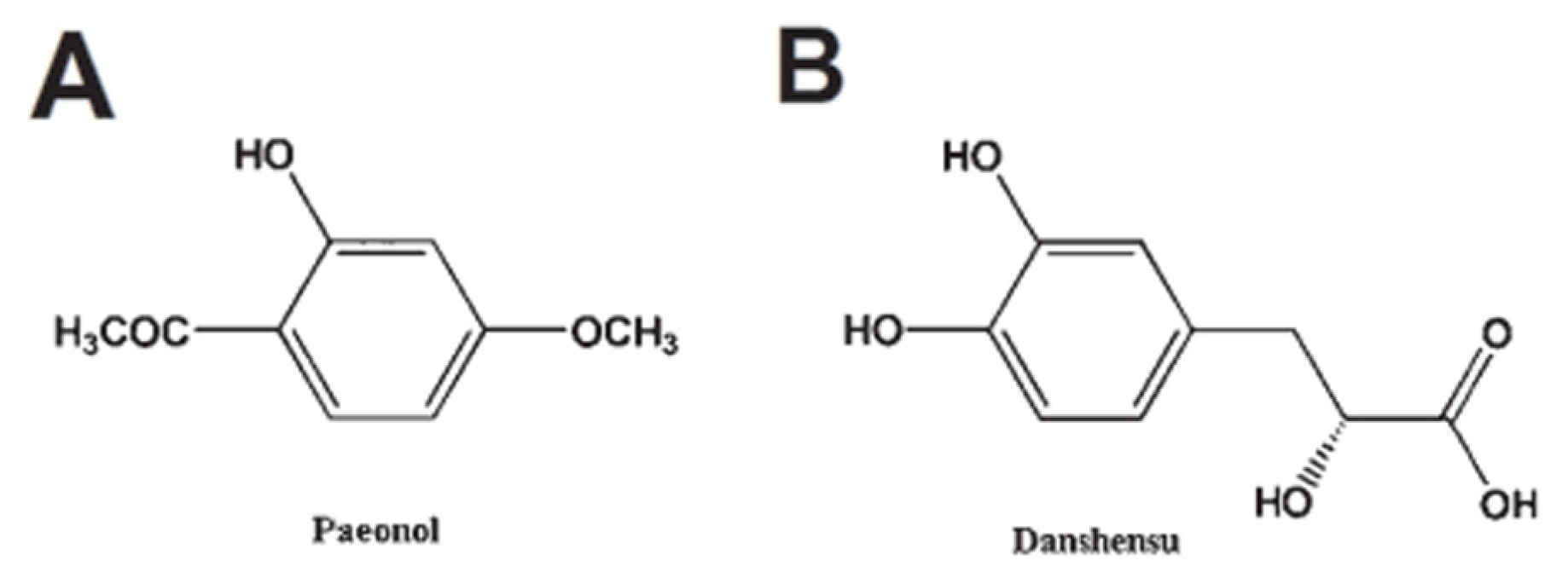
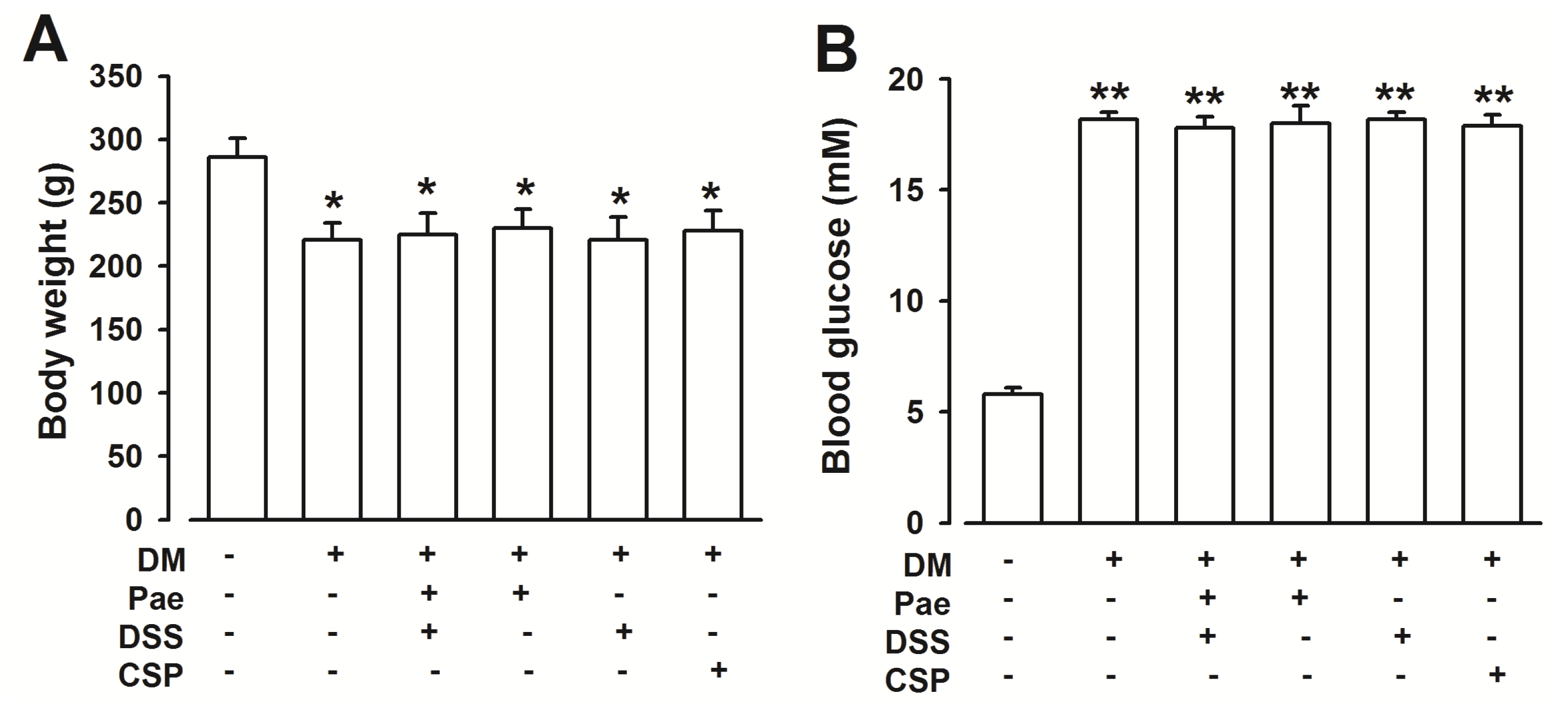

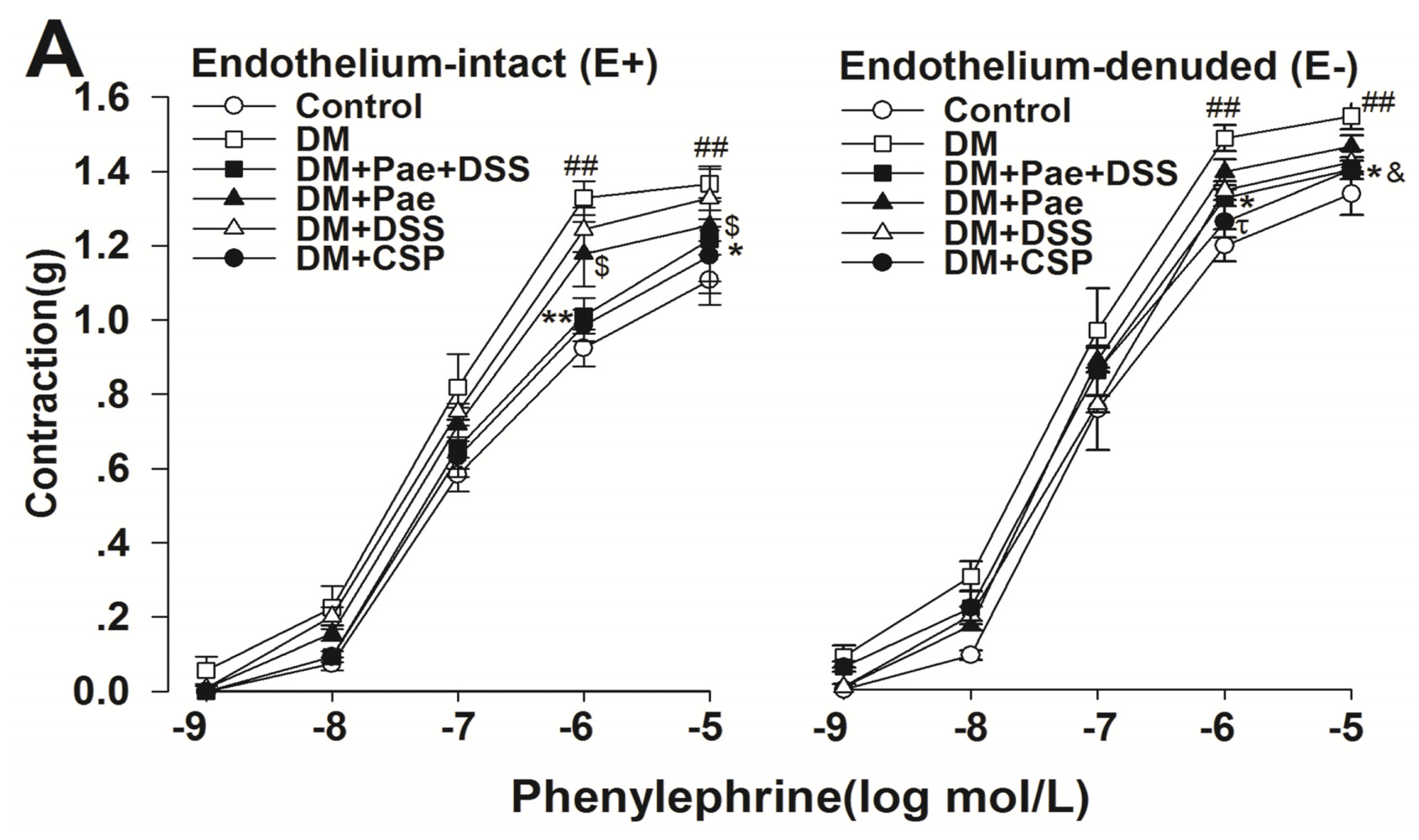
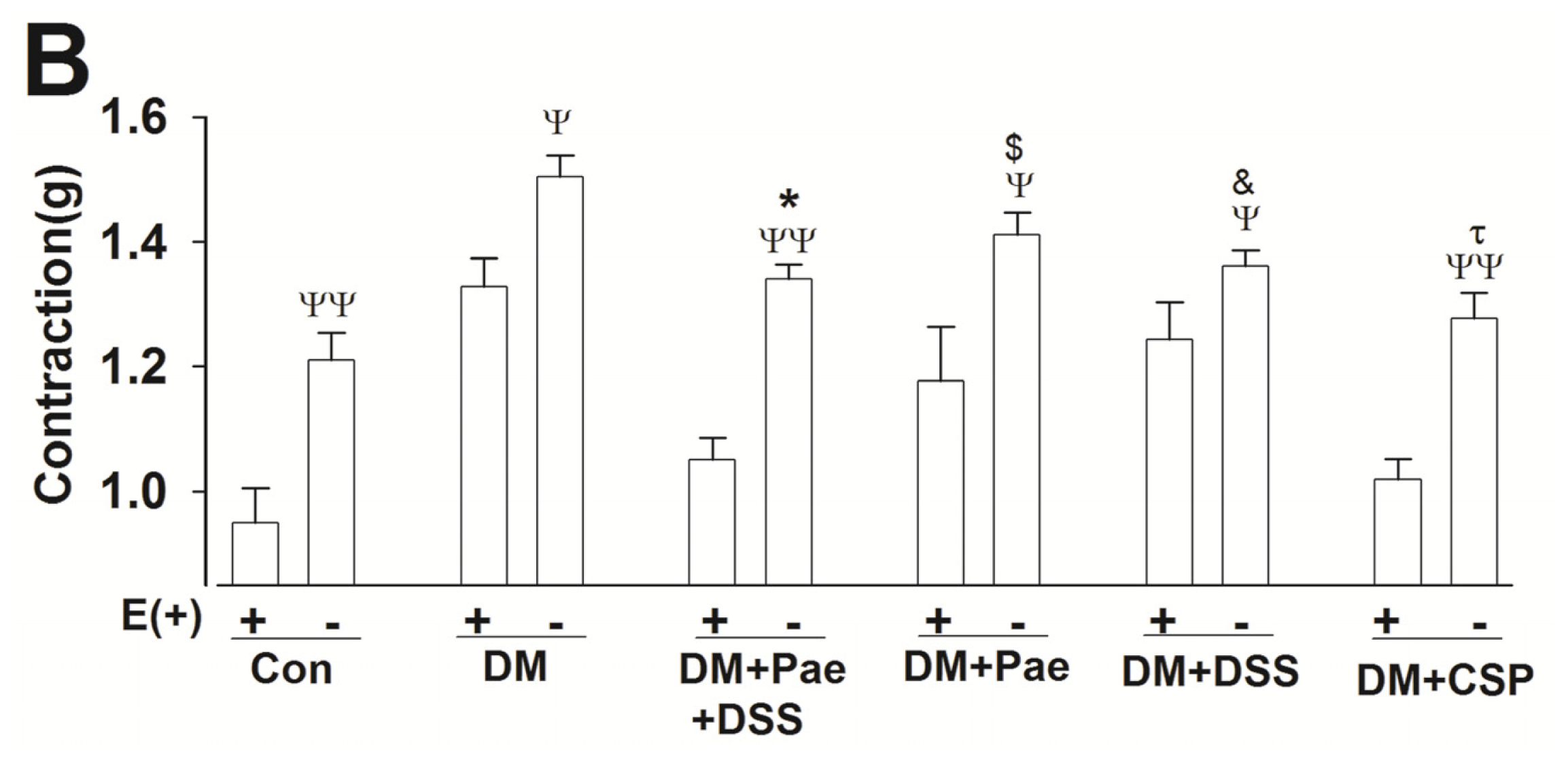

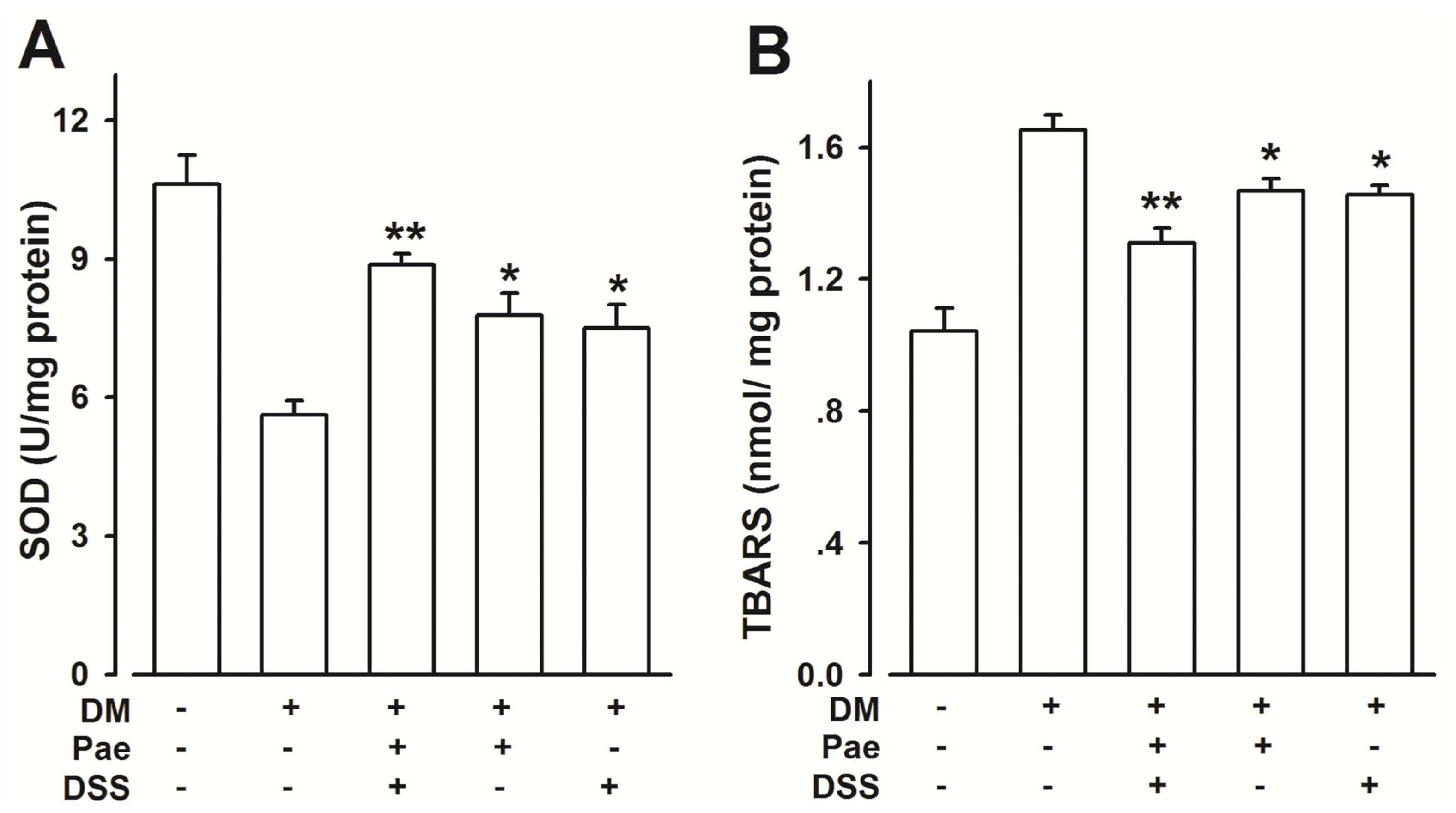
© 2012 by the authors; licensee Molecular Diversity Preservation International, Basel, Switzerland. This article is an open-access article distributed under the terms and conditions of the Creative Commons Attribution license (http://creativecommons.org/licenses/by/3.0/).
Share and Cite
Hu, J.; Li, Y.-L.; Li, Z.-L.; Li, H.; Zhou, X.-X.; Qiu, P.-C.; Yang, Q.; Wang, S.-W. Chronic Supplementation of Paeonol Combined with Danshensu for the Improvement of Vascular Reactivity in the Cerebral Basilar Artery of Diabetic Rats. Int. J. Mol. Sci. 2012, 13, 14565-14578. https://doi.org/10.3390/ijms131114565
Hu J, Li Y-L, Li Z-L, Li H, Zhou X-X, Qiu P-C, Yang Q, Wang S-W. Chronic Supplementation of Paeonol Combined with Danshensu for the Improvement of Vascular Reactivity in the Cerebral Basilar Artery of Diabetic Rats. International Journal of Molecular Sciences. 2012; 13(11):14565-14578. https://doi.org/10.3390/ijms131114565
Chicago/Turabian StyleHu, Jing, Ya-Ling Li, Zi-Lin Li, Hua Li, Xuan-Xuan Zhou, Peng-Cheng Qiu, Qian Yang, and Si-Wang Wang. 2012. "Chronic Supplementation of Paeonol Combined with Danshensu for the Improvement of Vascular Reactivity in the Cerebral Basilar Artery of Diabetic Rats" International Journal of Molecular Sciences 13, no. 11: 14565-14578. https://doi.org/10.3390/ijms131114565



